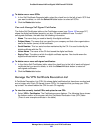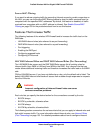
Network and System Management
326
ProSafe Wireless-N 8-Port Gigabit VPN Firewall FVS318N
rules, see Configure LAN WAN Rules on page 138 and Configure DMZ WAN Rules on
page 145.
When you define inbound firewall rules, you can furth
er refine their application according to
the following criteria:
• Services.
You can specify the services or applications to be covered by an inbound rule.
If the desired service or application does not display in the list, you need to define it using
the Services screen (see Inbound Rules (Port Forwarding) on p
age 133 and Add
Customized Services on
page 172).
• W
AN destination IP address. You can specify the destination IP address for incoming
traffic. Traffic is directed to the specified address only when the destination IP address of
the incoming packet matches the IP address of the selected WAN interface.
• LAN users (or DMZ
users). Only when the IPv4 routing mode is Classical Routing, you
can specify which computers on your network are affected by an inbound rule. When
Classical Routing is enabled, there are several options:
- Any. The rule app
lies to all computers and devices on your LAN.
- Single a
ddress. The rule applies to the address of a particular computer.
- Address range. The ru
le applies to a range of addresses.
- Group
s. The rule is applied to a group of computers. (You can configure groups for
LAN WAN outbound rules but not for DMZ WAN outbound rules.) The Known PCs
and Devices table is an automatically maintained list of all known computers and
network devices and is generally referred to as the network database, which is
described in Manage the Network Database o
n page 68. Computers and network
devices are entered into the network database by various methods, which are
describ
ed in Manage IPv4 Groups and Hosts (IPv4 LAN Groups) o
n page 67.
• W
AN users. You can specify which Internet locations are covered by an inbound rule,
based on their IP address:
- Any.
The rule applies to all Internet IP address.
- Single a
ddress. The rule applies to a single Internet IP address.
- Address range. The ru
le applies to a range of Internet IP addresses.
• Schedul
e. You can configure three different schedules to specify when a rule is applied.
Once a schedule is configured, it affects all rules that use this schedule. You specify the
days of the week and time of day for each schedule. For more information, see Set a
Schedule to Block or Allow Specific Traffic on
page 182.
• Bandwid
th profile. You can define bandwidth profiles and then apply them to inbound
LAN WAN rules to limit traffic. (You cannot apply bandwidth profiles to DMZ WAN rules.)
For information about how to define bandwidth profiles, see Create Bandwidth Profiles on
page 175.


















